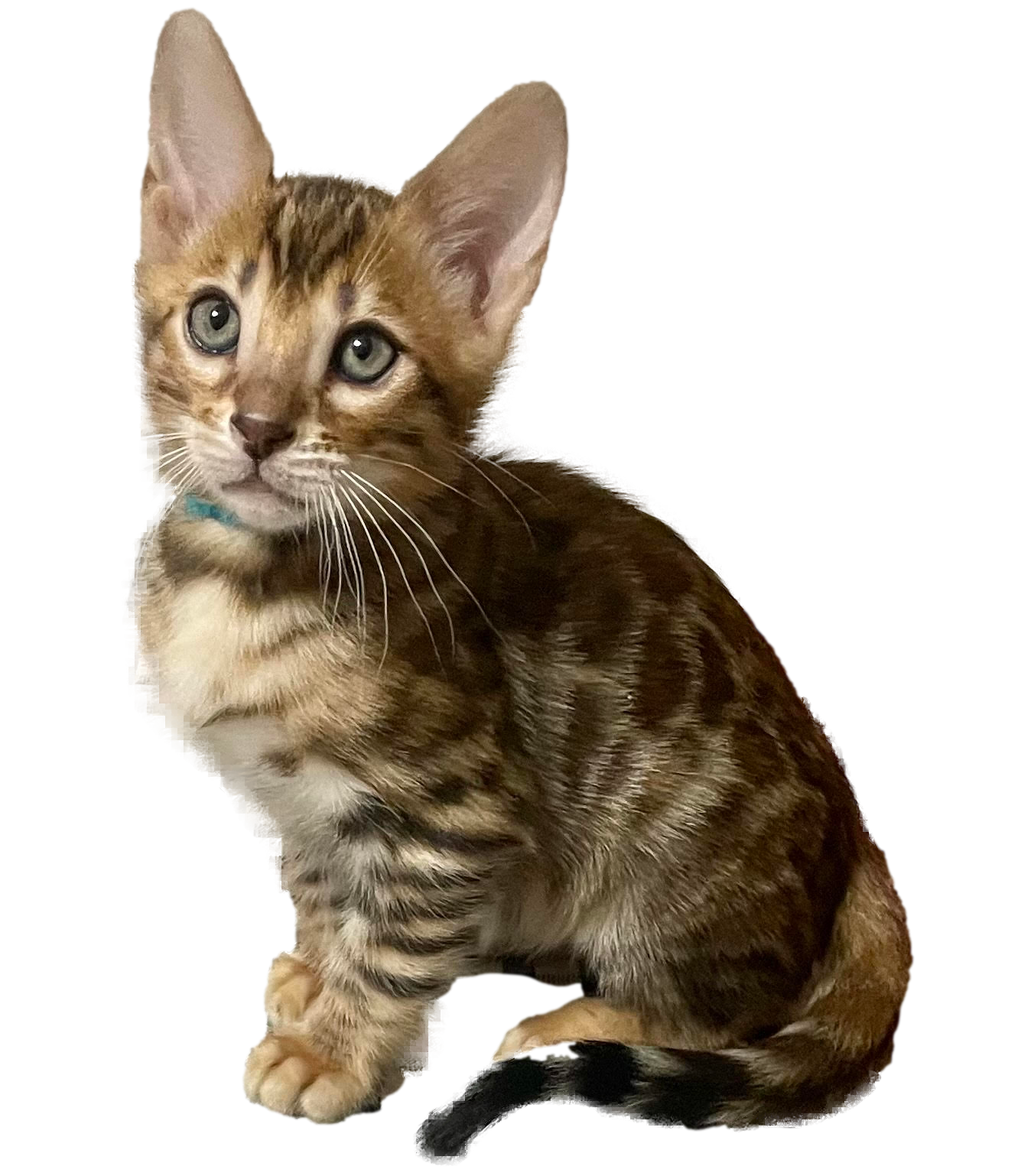About Bengal Cats
About Bengals
The Bengal cat comes from the Asian Leopard Cat, Felis Bengalensis (ALC) and somewhat resembles a Leopard. Based on their exotic appearance, they are sometimes described as “Living Art.” Their playfulness, social nature and spunky temperament make them unique family pets.
The ALC is a small wild cat species native to Southeast Asia. The ALC is similar in size to a large domestic cat but has a distinctly wild appearance and is covered with numerous black spots or rosettes. It generally has a slender, but muscular build and reaches an average weight around 10 pounds.
The first crossing of a domestic cat with an ALC reportedly occurred in the late 1800s. This and subsequent breeding efforts marked the beginning of Bengal cat development. In the 1960s, breeding efforts took on heightened intensity. According to published literature, Dr. Willard Centerwall, a pediatrics professor, was a cat fancier who studied feline genetics as a hobby. Dr. Centerwall was fascinated with the ALC based on its apparent resistance to the feline leukemia virus. He began breeding to study whether or not the trait could be passed to hybrid offspring.


Jean Sugden Mill, a cat breeder, also began crossing the ALC with domestic felines. While Mill received her first ALC from Dr. Centerwall in 1980, her motivation for creating a hybrid was different than the professor’s. While Centerwall was interested in feline genetics for health reasons, Mill’s interest was aesthetic. She sought to create a hybrid breed that looked like a wild cat, in part to discourage the fur trade.
Mill and Centerwall were not alone in their interest in hybridizing wild cats with domestic felines. In 1970, zoo keeper Bill Engler produced two litters of kittens he named “Bengals” by crossing his male ALC, Shah, with two female domestic cats. Engler reportedly commented that his goal was, “to create a small exotic cat that was beautiful and had a disposition suitable for a pet house cat”.
Engler has been credited with establishing the “Bengal” breed name, though that may be cat fancy lore. Some believe the name derives from the scientific name of the Asian Leopard Cat, Felis bengalensis. Others surmise it might be based on Engler’s name – B. Engler.
Through the dedication and hard work of Mill and others, the Bengal breed came to be recognized first by TICA and later by other cat fancy associations. The Bengal is now a frequently exhibited breed at cat fancy shows. Notably, to be an official registered Bengal cat today in a cat show, the cat must typically be at least several generations removed from any ancestor with a wild bloodline.
Currently, breeders typically focus on the breed’s appearance and personality. Modern Bengal cats tend to possess the beauty of a wild cat and temperament of a domestic cat.
They typically exhibit various fur patterns – spotted, rosette or marbled pattern. Each spot or rosette is outlined in a darker color, giving the look of a wild Jaguar. These patterns come in many colors, including brown, blue, silver, snow, charcoal and point. A frequently noticed feature is the wonderful coat the Bengal inherited from the ALC. They don’t have typical cat fur, but rather a silky cashmere pelt coat that is soft and sleek. Often it shines in the light with a glitter that permeates through every hair shaft. And most desirably, shedding is minimal. Physically, Bengal exhibit a muscular build yet are athletic and graceful. In terms of size, they are generally a little larger than the average housecat with males of the breed weighing between 10 and 15 pounds and females weighing between 8 and 12 pounds.
While the Bengal is not generally considered a lap cat, they are social, friendly and affectionate. They enjoy active playtime, can be mischievous and are usually fairly intelligent. Bengals usually like to play with other cats, dogs, and humans. They love to explore and sometimes have an affinity to play in water. Some describe the Bengal personality as “dog like” in that they may come when you call, fetch their toys when they want to play and can be trained to do tricks. They are rarely scared of new people and prefer to investigate them or greet them at the front door.
